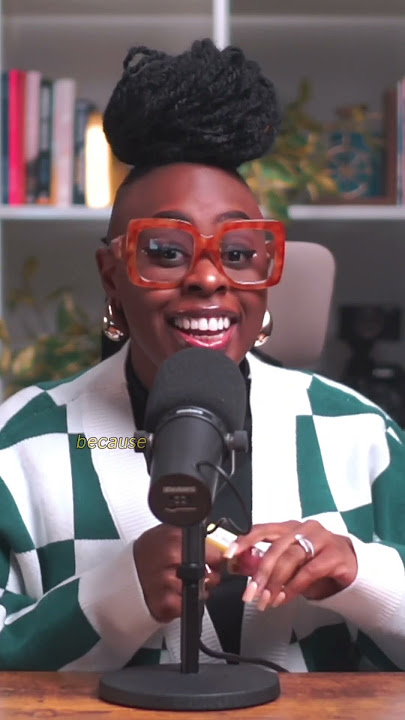Here’s what you need to hear about being part of the creator economy:
It’s likely the most exciting and lucrative opportunity available today. And there’s proof all around you.
You see independent creators making $10,000 every month from their small side hustle on Instagram. You’ve seen them build a personal brand and turn it into an income-generating machine. They make money from their business in several ways, from creating digital and physical products to affiliate marketing and partnering with brands on sponsorship and UGC projects.
And there’s the freedom and flexibility, control over their time, and the comfort that comes with being able to strike the kind of balance so many people can only dream of.
If this sounds like what you want to do too, but are not sure whether it’s worth it or not, read on. We created this guide, filled with trends that show what you can expect from the creator economy.
It’s also packed with statistics about the types of content that audiences are attracted to, the creator economy market size, insights on what content creator payouts look like from various platforms, how other creators are making money online, and so much more.
The State of the Creator Economy in 2025
It’s no secret that the creator economy is booming. But most people don’t know what’s driving this massive creator economy growth, and how platforms other than YouTube, Facebook, Instagram, and others, have created amazing opportunities for ambitious creators.
So what stand-out numbers should an aspiring creator see as proof of how large the opportunity in the creator economy really is?
Here are 9 that will raise your eyebrows and make you want to read on.
- The global creator economy had an estimated worth of $127.65 billion in 2023. (Coherent Marketing Insights)
- 85% of creators attended college. (Neoreach)
- The global influencer marketing market size has grown three-fold since 2019 and is now estimated to be worth $24 billion in 2024. (Statista)
- 63.2% of brands worked with the same influencers. (Influencer Marketing Hub)
- 36.5% of creators earn an income making lifestyle content. (Neoreach)
- There are over 207 million creators of which over 45 million are full-time creators and 162 million are amateurs. (Influencer Marketing Factory)
- 1 in 5 people consider themselves a creator. (HubSpot)
- 76.5% of creators made more money in 2023. (Epidemic Sound)
- 83.5% of creators expect to grow their income via monetization options available through social media platforms. (Epidemic Sound)
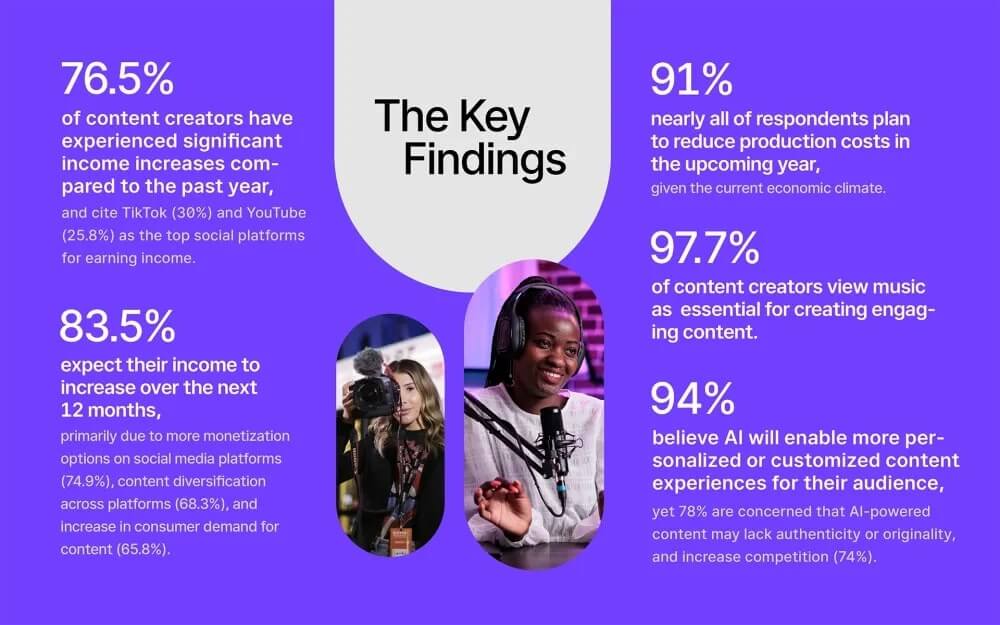
Image: Epidemic Sounds
A Closer Look at Creator Economy Trends
Long-form content is alive and well
Social media might want you to believe that short-form content is all that matters today — that it’s the only form of storytelling that is moving the needle for creators. But that’s just not true. Long-form content never really went anywhere.
It just appears as if it is experiencing what some might call a renaissance. More creators are learning that long videos and content offer greater depth. Depth is a major drawcard for curious audiences interested in expanding their knowledge to become specialists or experts.
Viewer consumption habits also show a startling discovery.
- 59% of Gen Z viewers use short-form video apps to discover content they then watch longer versions of. (Think With Google)
Webinars have also stood the test of time, proving that audiences will commit more than 30 minutes to learn something new.
- Long-form videos above 30 minutes, like webinars and live events, saw over 11,000% growth over the past decade, making it the fastest-growing video segment. (HubSpot)
And while video consumption is easier, reading content is still important and long-form pieces prove valuable for reaching larger audiences.
- Long-form content receives an average of 77.2% more backlinks than short articles. (Backlinko).
- Longer content gets more social shares than short blog posts, but articles that exceed 2,000 words receive fewer shares. (Backlinko)
“Longer-form content has become more popular again.”
I’m excited that longer-form content has become more popular again, with audiences keen to digest informative and high-value content from authority figures/brands. I think this is fantastic as it provides a really great opportunity for those of us in niche sectors to use our skills and experience to stand out with our content. Most importantly, we can do that without having to resort to short-form content aimed only at providing entertainment, which we may not be comfortable with, and may not fit with our brand image.
Takeaway: Lean into long-form content, it’s a way for your audience to gain deeper, more specialized knowledge or insights. Building a collection of long-form content will also help position you as a thought leader and authority in your niche.
Platform payouts are (still) disappointing
Early versions of creator fund-based programs succeeded in pulling large crowds of creators from almost every niche to social platforms. But like most new ideas, these programs have transformed.
For example, TikTok and Facebook have made substantial changes to how much they pay creators, eventually arriving at amounts as low as 2 cents for 1000 views.
- It’s estimated that TikTok pays around 2 to 4 cents per 1,000 views on a video. That means, if a video had one million views, TikTok creators could make between $20 to $40. And if your video went viral and you had 10 million views, TikTok pays between $200 to $400 from the creator fund. (Uscreen)
- The average cost for 1000 video views on monetized Facebook content is $10.97. Creators receive 20% of the revenue generated for long-form content featuring licensed music. (Uscreen)
And creators aren’t ditching platforms in protest. For some, it’s a matter of ROI. Mr. Beast recently declined Elom Musk’s offer to post content on X, mentioning that his videos cost millions of dollars to make and that even with billions of views on X, he’d run at a loss due to the platform’s current revenue share split.

These numbers make the growth of the creator economy seem doomed, but there are other ways to generate an income as a creator.
“The dwindling of creator funds is a trend that I am not excited about.”
The dwindling of creator funds is a trend that I am not excited about. I’ve seen this as a trend on platforms like TikTok and Instagram. It takes a lot to create and post on platforms, and although creators should never only depend on this stream of income, it is sad that they make almost nothing trying to feed an algorithm.
Takeaway: Views and ad-based monetization are harder to crack, so focus on monetizing your content in other ways. Leverage affiliate marketing, produce and sell merch and digital products, seek sponsorship deals, and more. Monetizing content in different ways can generate more income with fewer views.
More live streaming and interactive content
While there are several forms of content you can produce, stats point to live streaming and interactive content as highly engaging.
- Interactive content gets 52.6% more engagement than static content. (Mediafly)
Interactive content performs so well that marketers are committing more of their budget to it.
- Marketers said they would spend 14% of their budget on interactive content in 2023. (Semrush)
Live streaming is booming too…
- The video streaming market size, including live and on-demand streaming, is set to reach $416.84 billion by 2030. (Grandview Research)
- There was a 50% raise in the average number of live streams by store for the Faith & Spirituality industry from 2022 to 2023. (Uscreen)
And this boom isn’t a bubble driven by bullish investors, people are consuming large amounts of video content.
- Americans spend 21 hours a week streaming digital media in 2024. (Forbes)
This consumption trend shows that the OTT video industry is poised for greater growth.
- Revenue in the OTT video market is forecast to reach US$316.40bn by 2024. (Statista)
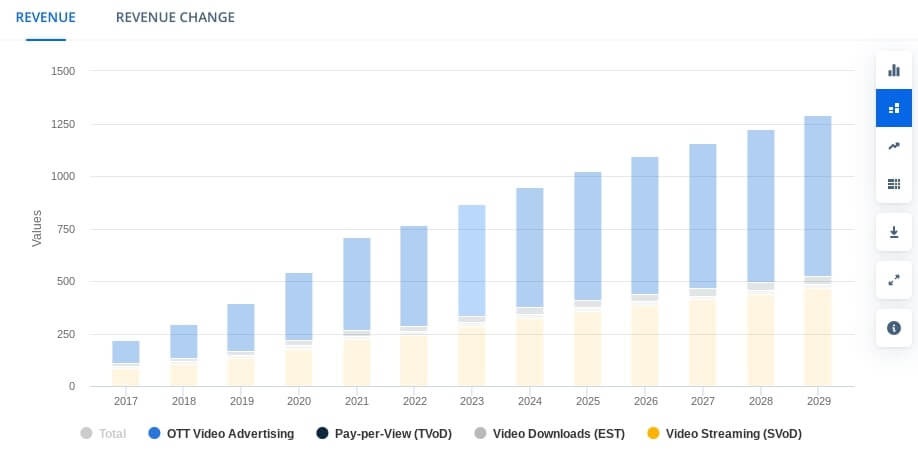
In a post-COVID world, streaming has taken a dip, however, this is to be expected as people return to in-person events.
- There was a 10% decrease in the amount of live streams in the Education industry. The same was noticed for the fitness and yoga industries, which shows a decrease since 2022. (Uscreen)
- The average live stream duration remained steady from 2022 to 2023, lasting for around 1 hour. (Uscreen)
- In 2023 the average watch time per livestream session decreased across most industries, except for Fitness (up 20%) and Media & Entertainment (up 15%). (Uscreen)
- The average viewer spent 40 minutes per livestream session in 2023. A total of 722K hours of live streams were watched throughout the year. (Uscreen)
Takeaway: Creators can capitalize on the growth of the OTT market, creating their own live streaming and video-on-demand platforms with paid membership monetization models. All-in-one video platforms like Uscreen provide all you need to build and scale a lucrative creator business without the need for coding skills or experience.
More creators will walk away from algorithms
If creating YouTube videos were a game, the constant algorithm changes and demonetization would feel a lot like playing in hard mode. For years, platforms have adjusted the way they reward content with more reach by prioritizing engagement to favoring watchtime.
And while terms like engagement and watchtime are common, there are also finer, not-so-clear details about how platforms work. These hidden levers directly influence what every content creator needs to do to generate the views, engagement, and watchtime that translates into a reliable income.
Relying on any platform’s next algorithm change for a living doesn’t have to be your reality. We strongly recommend that you lean away from the reliance on rented real estate you don’t own in favor of online real estate you own, like your own website, membership platform, and community hub.
That’s how you establish a real and sustainable business. When you own your real estate online you don’t have to hope for views and engagement. Your audience comes directly to you. You can sell directly to them.
- 58% of content creators in the US reported affiliate commissions as an income source, second to sponsored content (82%). (eMarketer)
You don’t have to worry about the platform metrics you’ve come to rely on for an income and whether they will change overnight leaving you helpless. You can embrace your content creator spirit and focus on producing your best work and serving your community. You’re also able to monetize your creative work in various ways.
For example, online entrepreneur and content creator Ali Abdaal understands the importance of owning a website. It’s where he collects email addresses for his newsletter which he uses to promote new courses and products.
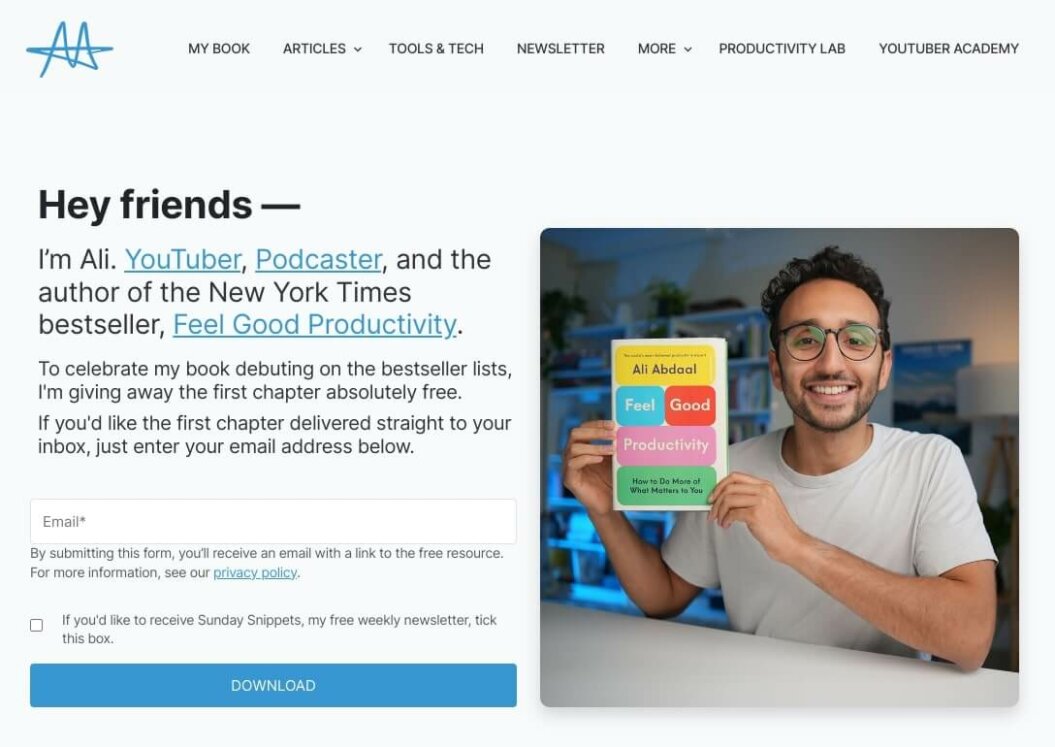
Online platforms can still be used as channels to reach new audiences, but when monetizing your content, relying on owned real estate will help generate a more sustainable income.
“I’m excited to see more creators taking their control back.”
Instead of being algorithm-dependent, creators are monetizing through memberships and selling digital products like templates, eBooks, and courses directly to their fans in addition to brand deals and affiliate marketing. Multiple streams of income is the name of the game and those who embrace that will find success.
Takeaway: Consider exploring other monetization strategies not heavily dependent on algorithms. For example, there are YouTube monetization alternatives to ad revenue, like building an email subscriber list with a weekly newsletter that automatically establishes direct contact with your audience, instead of a YouTube channel that doesn’t offer user details for direct marketing opportunities.
Creators create the Netflix experience
Netflix revolutionized online streaming as we know it, and with it, introduced the world to the world of subscription video-on-demand in a big way. As more people embrace apps and streaming services on their favorite devices, SVOD options are growing. More creators are producing their content on Netflix-style platforms for consumption wherever their audiences might be.
- 65% of streaming video is enjoyed on mobile and TV apps rather than on browsers. (Uscreen)
SVOD’s growth is staggering, proving that creators (with large and small audiences) can get in on the action with captivating storytelling.
- SVOD is expected to grow by $19 billion between 2023 and 2029 to $127 billion. (Digital TV Research)
- Global OTT TV episode and movie revenues are forecast to grow by $53 billion to $215 billion by 2029. (Digital TV Research)
- The global OTT video market size is estimated to top $476 billion by 2027 and the U.S. accounts for about 46% of that global market size. (Global Logic)
“I’m excited about the implementation of higher quality storytelling”
It’s always been something close to my heart, but it seems that this year, creators are prioritizing it more than ever. In an age of overstimulation, individuals are seeking to establish authentic relationships. Stories, I believe, are the ideal medium for fostering these connections in a genuine and effective way.
Takeaway: Demand for quality content is at an all-time high, and you can carve out a slice of the revenue pie with your own stories delivered to a community that pays to enjoy your work. What does that look like? Visit our customer stories for a look at how creators just like you turned their ideas into real, lucrative video businesses.
AI tools will make content creation easier
AI has made it easier for creators to research and produce content faster. Results from several surveys point to these productivity wins as strong competitive advantages.
- 88% of marketers believe that more automation and AI are essential to meeting customer expectations and staying competitive (Mailchimp)
- 83.2% of marketers say they will use AI tools to produce content in 2024. (Siege Media)
- Bloggers spend 30% less time creating content thanks to AI. (Wordtune)
AI isn’t just used to produce written content, it is leveraged to deliver video-based content too.
- 14% of bloggers say they use AI to generate content for webinars. (Wordtune)
Takeaway: AI can help you produce more content, faster, and make tasks like research and outlining content easier.
… But, creators will compete with more AI Content
As much of a low-hanging fruit as AI is, it’s a tool that almost anyone can use. It has enhanced the speed at which we can access and produce information, however, because the same tools are publicly available, true creativity has become even more important than ever.
The benefits of AI’s speed and access to information are appealing, however, most content creators see these and other capabilities as a threat.
- 81.6% of content creators think independent writers’ jobs are at risk because of AI. (Authority Hacker)
- 71.2% believe AI can outperform humans at their jobs. (Influencer Marketing Hub)
Others have embraced AI, evolving the way they produce content at scale.
- 100% of communications/media and real estate businesses use AI to assist with blog development. (CMO Survey)
- 76% of content creators use AI for basic content creation and generating copy. (Salesforce)
On the other hand, AI’s speed-to-market has proven that producing lower-quality content is, and will always be, present online. Creators who rely on AI to produce 100% of their content without the human touch risk hurting their brands.
Communities thrive in ecosystems where they know, like, and trust the ideas they are exposed to. When these core relationship pillars are eroded, there’s nothing to keep people coming back to consume what they consider inauthentic.
“Content creation is an art and it is much more compelling with our unique perspective.”
There seems to be a trend of “over-outsourcing” and relying too heavily on AI and automations. I’m all for leveraging tech to add more time back into your schedule but as content creators we really should temper that more. Content creation is an art and it is much more compelling with our unique perspective. We should be using AI as a production assistant, not a director.
Takeaway: The appeal of AI’s speed and access to information is not a substitute for creativity. It should be used as a supporting agent, helping research and identify ideas that you can develop and add your creative flare to.
More brands will listen to creators
It’s common for brands to have small marketing teams with a large pool of creative talent on call. While efficient, statistics show that smaller teams struggle to keep up with trends.
- Marketers consider ideation, creating engaging content, generating leads, and gaining followers as some of their biggest challenges on social media. (HubSpot)
This is why it appears that influencer marketing produces results for just a handful of brands.
- Only 12% of marketers have seen strong ROI from influencer marketing campaigns. (HubSpot)
But this is changing. Brand deals are evolving. Creators are finally being recognized as more than just a channel for influencer marketing. Brands are pulling creators into the creative process earlier on so that their collaboration is more… well, collaborative.
- 50% of marketers plan to invest more in influencer marketing in 2024. (HubSpot)
- 49% of marketers have worked with influencers on several occasions. (HubSpot)
“Brands will leverage creators earlier for consulting on the campaign.”
This year the number of brand collaborations with TikTok creators will increase, and the relationship between brands and all creators will continue to become less transactional, more collaborative, and brands will realize the value of bringing on creators into the process as early as possible. Brands will leverage creators earlier for consulting on the campaign, they will lead with curiosity and ask the creators more questions on how the brand should communicate with their audience instead of instructing, and brands will create deeper relationships with the creators that drive value.
Takeaway: Brand partnerships and collaborations are becoming more true to name. This year, when you land a brand deal, advocate for yourself to be involved as early in the process as possible. The brands that you work with will likely jump at the opportunity, and it almost always results in a win-win.
Building an online community will offer higher stability to creators
Creating a community is the surest path to building a scalable creator business. You’re building a brand that’s surrounded by fans who are your customers. These are people who identify with your brand beyond the purchase. They want to learn more and grow alongside other like-minded members.
And this shift to communities isn’t just something driven by creators. Audiences want to be part of communities too.
- 88.1% of consumers believe it’s important to have a two-way dialogue with brands so they can share feedback and opinions. (Tint)
- 76.6% of consumers wish their favorite brands had a community. (Tint)
- 40.1% of consumers are more likely to stay loyal to a favorite brand because of engaging with it in an online brand community. (Tint)
The creator economy market is bursting with opportunity and building a creator business around a community of members is also lucrative. In 2021, Justin Rhodes launched a paid membership platform with Uscreen for Abundance+, a homesteading content platform that teaches people how to grow their own food and live off the land. In 2023, he crossed the $100k a month revenue mark due to membership subscriptions.
Read the full case study here.
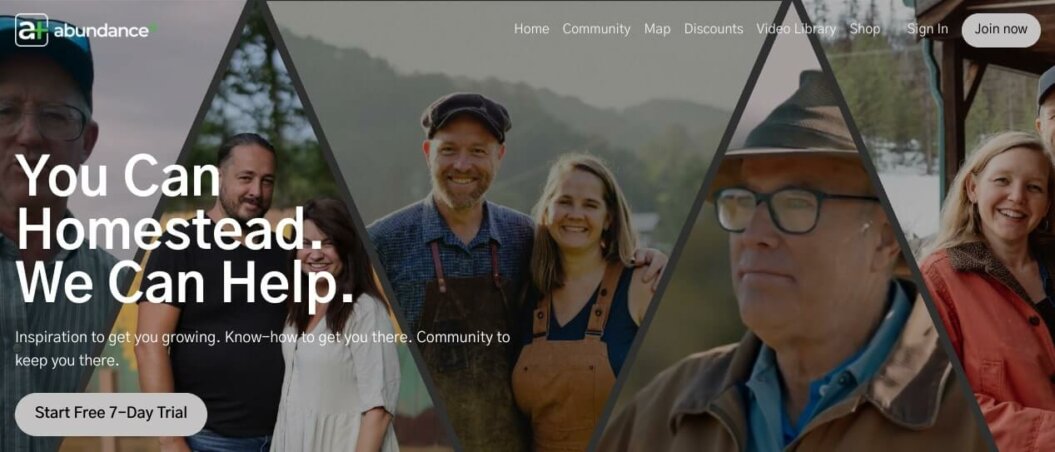
Or take Prodigies, a subscription music education platform founded by Rob Young. As a content creator, Rob wanted to find a more feasible way to share his passion for teaching, but small classroom settings proved limiting.
With Uscreen, Rob Young has scaled Prodigies to $40k+ a month and redefined success as a niche educator. He has several revenue streams, too. From selling big-ticket items to using shoppable videos to promote merchandise and digital products, he’s been able to scale his business and grow his income successfully.¯
Read the full case study here.
“A solid community is a lot like that one squad member who always has your back.”
Increasingly, creators are seeing the value of adding community to their social media presence and networks through platforms such as Discord and Guild. Not only does this help creators avoid daily battles with ever-changing social media platform algorithms to reach their audiences, community helps deepen relationships with fans and also gives them an opportunity to explore additional revenue streams with members. Creators are using monetization techniques such as tokenizing their communities, developing recurring revenue models through subscriber community spaces. Community doesn’t just happen.” It takes time and effort – something that creators innately understand, as many have built their personal brands from nothing.
Takeaway: Community is arguably the biggest key to success and stability as a creator. Invest time into building, nurturing, and monetizing your online community – in that order.
Companion content elevates storytelling
Content created once and never used again in any other format lost its appeal over a decade ago. Smart creators realized that being top-of-mind with relevant messaging was how you captured more attention, leads, and customers. Not repurposing your creative work, therefore, is a lost opportunity.
And today, creating several pieces of content from one larger piece of content or idea is just as crucial.
- 94% of marketers repurpose content and the remaining 6% plan to do so. (Referral Rock)
- 42% of marketers attest to updating and repurposing content as activities that led to successful marketing campaigns. (Semrush)
- 31% of marketers say content repurposing helps increase engagement with their content. (Referral Rock)
- 21% say it boosts brand reach and awareness. (Referral Rock)
- 15% confirmed that reusing content led to an increase in website traffic. (Referral Rock)
“Creators are now extending the runway for a given story to include companion content.”
Consumers are ingesting content in more ways and on more platforms than ever. One trend that has emerged and will be a driver going forward is the extension or repurposing of original content across other forms of media. We will no longer see a single streaming TV series or documentary that is done in isolation as a stand-alone piece of content. Creators are now extending the runway for a given story to include companion content. The ability to move across content platforms has taught consumers to want more from their content and to want flexibility in accessing it. Podcasts, like other content, no longer live solely in the realm of Spotify or other audio-only apps. Creators must be savvy to understand that all stories are now told in many ways and content served up through streaming, OTT apps and video vehicles now has an audience waiting for it there. Platforms like Amazon and Roku are now building their own smart TVs, an indication that the technology has both shaped and now drives consumer demand for streaming and internet-based content.
Takeaway: Your audience is looking for ‘bonus’ content. When planning your next video, consider repurposing your content into another format, or creating behind-the-scenes content to accompany it. This often requires much less effort and planning than the main video itself, so the return on investment could be big.
Start your creator journey with a membership site
The creator economy is only getting bigger and better in 2025. And as you’ve undoubtedly gathered from all the research and insights we’ve unpacked, the only way to capitalize on this massive opportunity is by taking action.
So jump in. Starting won’t cost you an arm or a leg either. Beginner creators just like you get going with free online platforms, build a community, and when you’re ready, take the next step. All you’ll need is a little planning and your innate creative ability.
Build, launch and manage your membership, all in one place.
Creator Economy FAQs
The entire creator economy’s estimated valuation is around $104.2 billion.
The passion economy is made of people who run projects and build businesses around purpose-led movements. These can be specific lifestyles or ideologies that a group of people resonate with or aspire to.
The creator economy consists of people who use their creative abilities to make an income. The passion economy includes creators who use their skills and talents to share their ideas, products, and services with the world.
The creator economy is driven by 4 factors which include:
Technology advancements:
The maturity of the backbone of the internet has made the internet more accessible to the world. More data centers and faster cross-continental fiber cables have been upgraded to afford stable and reliable internet access.
Platforms:
Online platforms have shrunk the world, making it easier for people to connect and engage with netizens from across the globe.
They have also made it easier to build communities and monetize them.
Anyone can hit record:
Recording equipment has become more affordable and easier to use. All creators require is a smartphone to start producing content.
Editing software is free or low-cost, allowing creators to produce quality content.
Brand growth and partnerships:
Brands wanting to grow have created the UGC industry which is estimated to be worth $4.4 billion at the end of 2022. UGC has supercharged the creator economy, allowing influences with large and small audiences to get paid for their creativity and access to their audiences.
Together, these factors have created the perfect ecosystem for ambitious creators to turn their skills and talents into an income.
The creator economy continues to prove the following monetization models successful:
Advertising revenue:
Ad revenue is a common revenue generation model. Platforms pay creators a portion of the revenue generated from advertising run alongside creator content. YoTube is popular for their Adsense program where many creators earn 40% of the revenue advertisers pay YouTube to show ads.
Influencer marketing using UGC:
The global influencer market is driven by social media influencers and video creators. Influencers offer direct access to communities of people that brands want to reach, making user-generated content about products and services a lucrative opportunity.
Affiliate marketing:
Full-time creators and many professional creators earn a commission by promoting products or services and including affiliate links in their content. They receive a percentage of the sales made through those links.
Selling exclusive content or merchandise:
Selling exclusive content and merchandise is a smart and almost hands-off way to earn an income. You can sell branded merchandise such as clothing, accessories, or digital products like eBooks or courses.
It’s hands-off because you can dedicate time, say a week creating content, package it, and sell it over and over again. And beginner creators can do this too.
Selling subscriptions and memberships:
Monthly subscriptions are a fast way to generate a reliable source of income as a content creator. From subscription-based services, such as premium newsletters, access to online communities, or personalized content, there are several ways to tap into recurring revenue.
Host events and workshops for fee:
Hosting live events, workshops, or webinars is a great source of income for content creators. All you need do is identify a problem your audience wants to solve and produce an event around it, sharing solutions. You can charge for admission or offer paid access to exclusive sessions.


